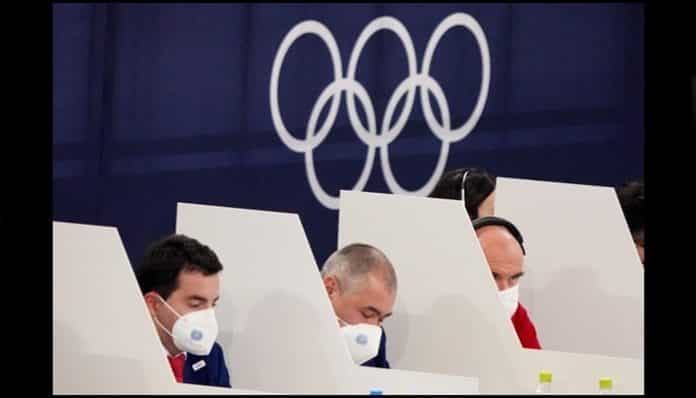
July 26 (UPI) — Japan is staging the Summer Olympics during a state of emergency and without spectators in the Tokyo metro area with coronavirus cases surging, though its situation is nowhere nearly as dire, with a much lower fatality rate than many other nations.
On the third day of the Olympics, Japan announced four additional deaths and 5,020 cases. The nation is 37th in the world with 15,141 fatalities and 33rd in infections with 871,449. In the past week, Japan’s deaths have decreased 5% with 89, and cases rose 50% at 27,538, which is 216 per million population compared with Britain at 3,881, Indonesia at 1,045 and the United States at 977.
The nation’s daily records are 148 deaths on May 7 and 7,568 cases on Jan. 7.
In Tokyo, where most of the events are taking place and the population is 12.5 million, 1,763 cases were reported Sunday compared with 1,008 seven days earlier.
Worldwide, cases are up 3% and deaths 4%, according to Worldometers.info.
In Asia, deaths have climbed 16% over seven days with cases increasing 4%, led by big gains in Indonesia with India subsiding after being the top hotspot in the world.
One and a half years after the virus originated in Mainland China, the death toll has risen to 4,174,876 and cases are at 194,802,077 through Sunday, according to tracking by Worldometers.info.
The United States is the world leader in total deaths at 610,891 and cases at 34,443,761, according to tracking by Johns Hopkins. Brazil is second in fatalities with 549,500 and India third with 420,551. India is second in cases at 31,371,901 ahead of Brazil with 19,670,534.
Japan’s fatality rate of 120 per million compares with a worldwide figure of 535.2 and 1,882 in the United States. Cases are at 6,867 per million compared with 24,963 globally and 104,640 in the United States.
But Japan is facing two worrisome situations: relatively low vaccination and testing rates.
In Japan, 35.3% of the population has received at least one vaccine dose and 23.8% are totally vaccinated.
The United States has administered at least one dose to 56.6% of its population with Brazil at 46.8%. India’s one-shot rate is 24.6. China doesn’t report dose percentages but has enough for 54.5% of the world-high 1.5 billion people.
Worldwide, a total of 3.82 billion shots have been given in a population of 7.9 billion with a two-dose regimen required for most brands, according to tracking by Bloomberg.
Europe has administered 82 doses per 100 people, followed by North America at 81, South America at 57, Asia at 52, Oceania at 31 and Africa at 4.6, according to tracking by The New York Times.
In testing, Japan’s rate is only 141,938 per million compared with the United States at 1.6 million per million.
All Olympic athletes and personnel are tested frequently with 169,095 performed through Friday.
The total number of Games-related cases is 132, according to Tokyo 2020 organizers Sunday. Fifteen cases have been reported out of the Olympic Village and 15 total athletes, including residents and non-residents of Olympic Village, have tested positive.
Safety protocols including requiring athletes to wear masks when they are not competing, including on the medal stand except for brief moments, are being used at the Olympics.
During his speech at the Opening Ceremony on Friday night, IOC President Thomas Bach noted “the pandemic forced us apart, to keep our distance from each other, to stay away even from our loved ones. This separation made this tunnel so dark. But today, wherever in the world you may be, we are united in sharing this moment together.”
And he praised the work of the health personnel as well as the volunteers.
Only about 1,000 dignitaries were in the stadium, as well as the media. Former Prime Minister Shinzo Abe, who was instrumental in securing Japan’s bid to host the Games in 2013, was not present. In 2020, he agreed to postpone the Summer Olympics.
In Japan, 78% of the residents oppose the games taking place, according to a poll released last week by Ipsos Global Advisor. Protesters were outside the stadium of the Opening Ceremonies.
Asia leads the continents with 60,493,268 cases and fourth in deaths at 870,123 behind No. 1 Europe, No. 2 South America and No. 3 North America.
Three Asian nations are in the top 20 for most deaths. Besides India, Iran is 13th place with 88,800, and Indonesia 14th at 88,800, moving up two spots.
Indonesia’s deaths spiked 35%, including a record 1,566 Friday then 1,266 Sunday, with cases down 14% with 38,679 Sunday after a record 56,757 10 days ago. Until mid-June, the most infections were 14,226 and deaths were 476 in January.
Indonesia has inoculated only 16.6% of its population with at least one dose.
On Sunday, President Joko Widodo announced the extension of restrictions by a week to Aug. 2. On July 10, Indonesia began a lockdown.
In India, coronavirus has been trending down from a world record of 4,529 deaths and world cases mark of 414,188.
In the past week, infections are down 1% and fatalities dropped 16%.
On Sunday, India reported 39,742 cases and 535 fatalities. India’s one-shot vaccination rate is 24.6% though the nation is a dominant manufacturer of vaccines worldwide.
The highly contagious Delta variant was first detected in India last October and has become the dominant strain worldwide.
Prime Minister Narendra Modi last week mentioned the need “to stay vigilant looking at the situation in various countries.
“Mutations make this disease very unpredictable, and hence we all need to stay together and fight this disease,” he said.
The pandemic began in late 2019 in Mainland China, but the nation with the world’s largest population of 1.5 billion, has reported only a few deaths in the past 12 months and stands in 67th at 4,636 behind Costa Rica with 4,941. China added three cases Sunday and had administered more than 1.5 billion doses, the most in the world and dwarfing India with nearly 433 million and the United States with more than 339 million, according to tracking by Johns Hopkins.
South Korea has vaccinated 32.6% of its population. The nation has 2,073 deaths, including five more Sunday, a rise of 1,486 cases, three days after a record 1,838.
Restrictions throughout South Korea remain in place and they will be expanded to other regions. On Sunday, the nation announced stronger social distancing rules across most of the country this week, including a 10 p.m. dining curfew and ban on gatherings of more than four people starting Tuesday for two weeks.
“What’s most concerning is the virus’ recent spread in the non-capital areas,” President Moon Jae-in told an intra-agency meeting reviewing efforts in the campaign against the coronavirus. “There has been an increase in movements nationwide, especially around vacation spots.”
Turkey is seventh in the world for cases, dropping behind Britain in the past week at 5,601,608, including 14,230 Sunday, and 19th in deaths at 50,934, including 55 most recently.
Coronavirus also is surging in Thailand, 38% in cases over the past week with a record 15,335 Sunday and 12% deaths with 129 most recently for a total of 4,059.
Israel, which is considered part of Asia, has fully vaccinated 63.6% of its population. Its death toll is 6,459 with 10 reported in a week and one Sunday.
In Europe, four nations are in the top 10 for most deaths. Russia is sixth with 153,874, Britain seventh with 129,158, Italy eighth with 127,949 and France 10th with 111,622. Also, Germany is 12th with 92,037, Spain 15th with 81,221, Poland 16th with 75,242 and Ukraine 18th with 52,847.
Europe’s cases grew by 6% for a current total of 50,730,774 and deaths by 3% at 1,126,783.
Deaths have been spiking in Britain with a one-week increase of 447 at 57%, and 28 reported Sunday and 96 Tuesday, the most since March. Cases declined by 4% and most 29,173 recently. Britain’s records are 1,823 deaths and 67,803 cases, both in January.
The situation is concerning in Britain despite 69.6% of the population receiving at least one vaccine dose, including the first person in the world in December.
Elsewhere in Europe, Spain had vaccinated 65.6% with at least one dose, Italy 61.7%, Germany 60.8%, France 61.4%, Poland 47.4%, Russia 22.9 and Ukraine 11.2%.
Russia reported 779 deaths Sunday after a record 799 earlier this month. Cases were 24,072 compared with the record 29,935 in December.
Also Sunday with only single-digit increases: Italy seven, France six, Germany one, Ukraine 12, Poland 1. Spain doesn’t release data on the weekend.
Last Monday was “freedom day” in Britain, when most of the restrictions were lifted in England as well as Scotland and Wales. Social-distancing rules in England ended, though guidelines advise face masks should still be worn in enclosed spaces and on public transport, and pubs and bars should be table service only.
But the surge in cases is forcing hundreds of thousands of workers to stay home, causing shortages of food and gasoline.
In France, police clashed Saturday in central Paris with unmasked protesters against COVID-19 restrictions and vaccine passports. About 160,000 took to the streets.
Also in Italy, thousands of people protested the government’s requirement that starting Aug. 6, residents must show a so-called green pass. This is a version of the European Union’s digital COVID certificate.
In both nations, proof of a vaccine or a negative test is required to attend large events, as well as cinemas, museums and theaters.
On July 1, the European Union launched the certificate, which allows for free movement of travelers between its countries.
The 29 nations in Europe’s Schengen area, as well as those in Britain and Ireland, remain barred from traveling to the United States unless they are a U.S. citizen or they spend 14 days before arrival in a country that is not on the Centers for Disease Control and Prevention’s prohibited list. The United States has not lifted its travel ban to Europe.
Last week, the United States extended its nonessential travel ban with Canada and Mexico to Aug. 21. It began one year ago in March. Two weeks ago, Canada announced it was reopening to vaccinated Americans.
In North America, cases have surged 34% and deaths 10%, fueled by spikes in the United States.
The United States posted a 531,931 gain in cases, or 47%, though deaths dropped 4% at 1,824, according to Worldometers.
The continent’s totals are 934,342 deaths and 41,827,328 cases.
On Sunday, 171deaths and 15,711 cases were reported though a majority of states don’t report data. Friday’s infections increase was 118,791 but that included a week’s worth of cases from Florida, 73,166. Florida leads the U.S. in weekly cases and deaths.
Mexico’s deaths are up 45%, with 108 Sunday and fourth in the world at 238,428. Deaths are way down in Mexico from a one-day record of 1,803. The nation’s cases are up 30%, ranking 16th in cases at 2,748,518 with 6,535 most recently.
Canada’s cases are down 19% in one week and deaths rose 17%. Canada’s record is 257 on Dec. 29 with a total of 26,437 in 26th, dropping behind the Philippines in one week including three Sunday. Cases reported were 228, down from the record of 11,383 on Jan. 3.
Mexico’s vaccination rate is 31.8%, though it was the first Latin American nation to begin vaccinating people. And Canada has risen to 70.6% and leading the United States by 14 percentage points after lagging by several points for months.
Mexico’s stoplight color system added more regions to higher risks. On Monday, Mexico City and México state will switch to orange through at least Aug. 1. In all, 13 entities are orange, including the Yucatan with tourist places Cancun and Cozumel,
The one maximum risk red state is Sinaloa and three are designated as green light.
Around 3,400 hospitalized Covid patients are in the metropolitan area of Mexico City, an increase of more than 800 compared with a week ago. Most cases are young people and they are mainly unvaccinated.
South America has four nations in the top 20 for most deaths. Besides Brazil, Peru is fifth with 195,890, Colombia ninth with 118,868 and Argentina 11th with 103,721.
Overall, South America has 1,077,346 deaths and 35,131,605 cases.
Brazil’s fatalities decreased 2% and cases are down 4% with 499 reported Sunday. The nation set a record 114,139 cases four weeks ago with 18,129 most recently. The deaths record is 4,211 in January.
Chile has the highest vaccination rate on the continent at 71.3% and is 20th in deaths worldwide with 35,026 and 68 Sunday, with Argentina 52.2%, Colombia at 31.1% and Peru 22%.
On Sunday, Colombia reported 330 deaths, Argentina added 137 and Peru gained 95.Brazilian President Jair Bolsonaro, who refused to be vaccinated and contracted the disease one year ago, has been spreading misinformation, according to YouTube. The social media platform removed a number of videos last week.
“Our policies don’t allow content that claims hydroxychloroquine and/or Ivermectin are effective to treat or prevent COVID-19, claims that there is a guaranteed cure for COVID-19, and claims that masks don’t work to prevent the spread of the virus,” according to a statement obtained by CBS News. This is in line with the guidance of local and global health authorities, and we update our policies as guidance changes.”
Last year Facebook and Twitter removed posts by Bolsonaro.
Oceania, with only 42.3 million people, has 1,475 deaths with an increase of 187%, or 109, in one week and cases are 96,448, up 7,578 to 3%.
New Zealand’s deaths remain at 26 with the last one reported on Feb. 16 and Australia’s toll increased to 918, with two reported Sunday and four in a week.ustralia was up 160 129, which is 1,016 in a week, for 32,915
Australia has vaccinated 28.5% of its population. New Zealand has administered first doses to 18.8% of its population.
Despite only dozens of new cases, more than half the population, including those in state capitals Sydney, Melbourne and Adelaide, remain under lockdown measures.
“Australia was a penal colony, and it kind of feels like that now,” Genevieve Neve, a 38-year-old actor, originally from San Diego, who moved to Australia as a teenager with her family, told CNN. “We feel like prisoners in this country.”
And around 37,300 Australians registered overseas want to return home, according to the Department of Foreign Affairs and Trade.
The outbreak also has been surging in Fiji with 186 total deaths, compared with 98 one week ago and four by May 3. Deaths rose by nine Sunday. Cases have climbed from 121 on May 3 to 23,139, including 626 most recently.
Africa’s deaths grew 3% for a total of 164,792 and the weekly case change dropped 16% to a total of 6,521,933.
South Africa’s 84,225 new weekly cases accounted for 35% of the continent’s 238,922 infections. Deaths are up 11%, to 2,812 in one week. South Africa is in 17th place with 69,775 deaths, including 287 Sunday. And cases rose 9,718.
Tunisia has the second-most deaths with 18,600, with an increase of a record 231, ahead of Egypt with 16,487.
A more contagious variant originated in South Africa, which has vaccinated 8.9% of its population with at least one shot.
“Be under no illusions, Africa’s third wave is absolutely not over. This small step forward offers hope and inspiration but must not mask the big picture for Africa,” Dr. Matshidiso Moeti, World Health Organization regional director for Africa, said in a U.N. media report. “Many countries are still at peak risk and Africa’s third wave surged up faster and higher than ever before. The Eid celebrations which we marked this week may also result in a rise in cases. We must all double down on prevention measures to build on these fragile gains.”






